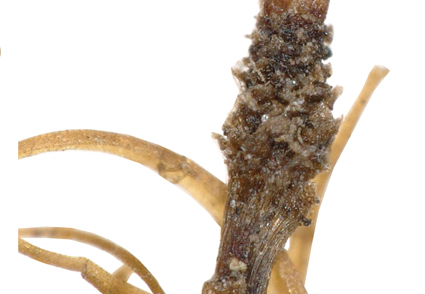Abstract
Dicranodontium tenii Broth. & Herzog in Herzog (1925: 150), initially described based on a specimen collected from Yunnan Province, China, was later suggested by Frahm (1997) to be identical to Dicranum hamulosum Mitten (1891: 156). However, the detailed morphological descriptions and excellent illustrations of these two species, based on the type specimens provided by Noguchi (1987) and Gao (1994) respectively, offer convincing evidence of their distinctions. For instance, Dicranum hamulosum lacks differentiated epidermal cells on the ventral side of the costa, while they are well-differentiated in Dicranodontium tenii (Noguchi 1987; Gao 1994).
References
- Bruch, P. & Schimper, W.P. (1847) Fasc. 41. Dicranodontium, Campylopus, Oncophorus. In: Bruch, P., Schimper, W.P. & Gümbel, W.T. (Eds.) Bryologia Europaea. E. Schweizerbart, Stuttgart.
- Frahm, J.P. (1997) A taxonomic revision of Dicranodontium (Musci). Annales Botanici Fennici 34: 179–204.
- Gao, C. (1994) Flora Bryophytarum Sinicorum. Vol. 1. Science Press, Beijing, 368 pp. [in Chinese]
- Hedwig, J. (1801) Species Muscorum Frondosorum. Joannis Ambrosii Barthii, Lipsiae, 352 pp.
- Herzog, T. (1925) Beiträge zur Bryophytenflora von Yünnan. Hedwigia 65: 147–168.
- Ireland Jr, R.R. (2007) Dicranum (Family Dicranaceae). In: Flora of North America Editorial Committee (Org.) Flora of North America, Volume 27. Oxford University Press, Oxford, pp. 397–420.
- Mitten, W. (1891) On the species of Musci and Hepaticae recorded from Japan. Transactions of the Linnean Society of London, 2nd series: Botany 3: 153–206. https://doi.org/10.1111/j.1095-8339.1891.tb00626.x
- Noguchi, A. (1987) Illustrated Moss Flora of Japan, Part 1. The Hattori Botanical Laboratory, Nichinan-Shi, 242 pp.
- Willians, R.S. (1913) Dicranaceae. In: Britton, N.L. (Ed.) North American Flora, series 2, 15. New York Botanical Garden, Bronx, pp. 77–158.


